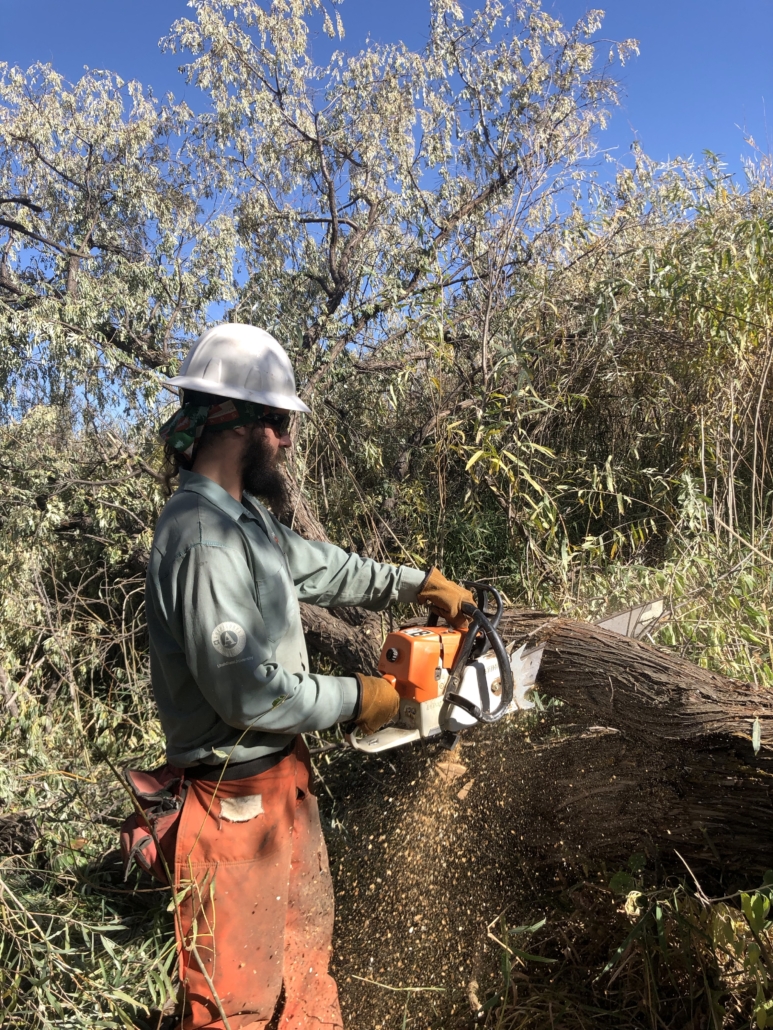Congratulations to Utah Conservation Corps on winning a 2024 Project of the Year Award! Awardees will be recognized at The Corps Network’s National Conference – #CorpsCon24.The conference will be held March 19 – 21, 2024, in Washington, DC. Click here to learn more about #CorpsCon24. Click here to learn more about #CorpCon24 awards. Click here to learn about the 2024 Project of the Year finalists.
Utah Conservation Corps
The Bia Ogwa habitat restoration project is not only helping 11,000 acre-feet of water flow down Bia Ogwa (also known as Bear River), but is also helping the Shoshone Nation to reclaim their land and heritage.
Over the past 160 years, the riparian habitat along the Bear River has become severely degraded. The site is the location of the Bear River Massacre, the worst slaughter of indigenous people in US history which occurred on January 29, 1863. The Shoshone Tribal members that still live in Franklin County, Idaho, are direct descendants of the survivors. The site was returned to the Shoshone Nation in 2002 and in 2018 the Tribe purchased 550 additional acres. The Tribe has plans to build a Cultural Interpretive Center near the site to educate visitors on the history of the Northwestern Shoshone Band, the tragic massacre, and more.
The goal of the Bia Ogwa project is to redevelop the area and restore the natural habitat to the state it was when inhabited by the Tribe in pre-colonial days, and to make it more resilient.
The Big Ogwa restoration has been ongoing. In 2021, Utah Conservation Corps (UCC) AmeriCorps crews treated 11.62 acres along the river. This included removal of over 1,600 invasive Russian olive trees, repairing fencing on the site, and preparing soil for propagating native vegetation around the site. In 2022, UCC crews returned to treat 9.14 acres, remove more invasive species and repair more of the fence. This fall, UCC assisted the Tribe in preparing the site for volunteer planting of approximately 4,000 native trees.
This work has several landscape benefits. By removing water intensive invasive species, riparian habitat improves and downstream water quantity increases. Water quality has also improved through the restoration of a diverse community of native species. This in turn helps improve the health of the Great Salt Lake that Bear River feeds into, and to the Bear River Migratory Bird Refuge.
The Shoshone Nation Vice Chairman, Brad Parry, said of the partnership, “We are grateful that the UCC has agreed to work with us on this very special project. This is the first step in creating the spiritual feeling we want to create at the site.”
The Bia Ogawa restoration project is the first tribal partnership project that UCC has completed and there are plans to continue helping the Tribe restore the site to its pre-colonial state. Over the past couple years, at the start of the season, the Tribal elders have conducted an opening ceremony to bless the site, promote healing and to protect the UCC members.
Corpsmembers have benefited from the project in many ways. Not only does it combine the Corps goals of habitat and cultural restoration, but it also allows for Corpsmembers to work alongside Tribal members along with private environmental consultants; Hansen Allen & Luce Engineering and BioWest Inc. This helps Corpsmembers develop appreciation for Tribal culture and gain valuable conservation skills.
The community is grateful for the work. Shoshone Nation Vice Chair said of the project, “The feeling on the land is beginning to change to one of peace and happiness, whereas before, it was a lot of sorrow.”





































































